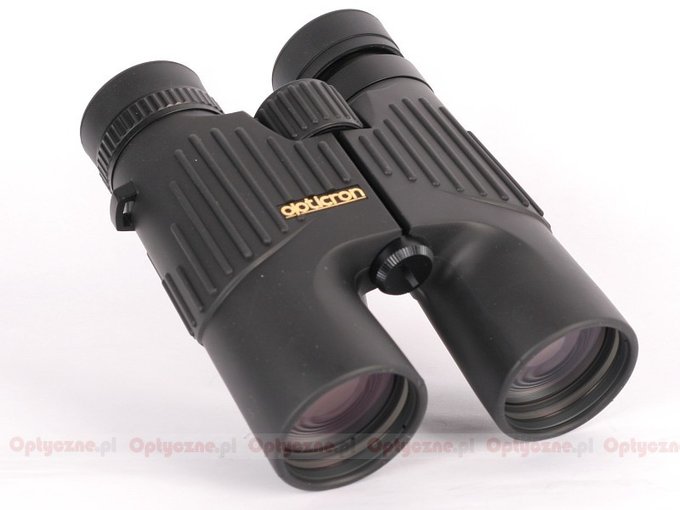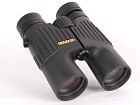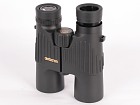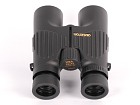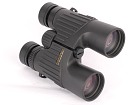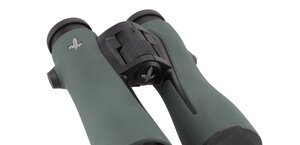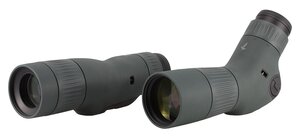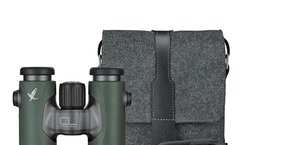The British Opticron is the counterpart of the Polish Ecotone company. This company orders binoculars in the factories in China and in Japan and then sells them under their own brand name. Because Opticron is present on a very large market with an especially big numbers of ornithologists, its offer is really huge - over one hundred models!
This company’s more expensive models are, by and large, an example to be followed when it comes to attention to detail and accessories. Every model comes with a stylish hard case, often we get two sets of caps, two straps - one for binoculars and the other for the case - a cleaning cloth for the lenses, a detailed instruction and a written guarantee.
The DBA Oasis series is the flag series of this producer and it consists of two models with the parameters 8x42 and 10x42. The binoculars have BaK-4 glass roof prisms put in the Schmidt-Pechan system. One side of the elements is phase correction coated, the other covered by a 64-layer Oasis coating, which task is to reflect 99% of the light and to enhance efficiently the transmission level of the whole instrument. The DBA Oasis series instruments include also aspherical lenses and a very comfortable eye relief, amounting to 18 mm.
The binoculars are waterproof down to a depth of five meters, nitrogen-filled and they come with a 30-year-long guarantee. Additionally a rich delivery scope should be mentioned here – it includes a leather hard case, double set of caps, two straps and a cleaning cloth.
Distribution / Sales:
Olbrycht Trade sp. z.o.o.
web site
| Magnification |
Lens diameter |
Angular field of view |
Prisms |
Eye relief |
Weight |
Price |
| 10 |
42 |
105/1000(6o) |
BaK-4/Dachowe |
18 mm |
695 g |
3950 PLN |
|
|
| Real front lens diameter |
Left: 41.49+/-
0.05 mm
Right: 41.6+/-
0.05 mm
|
5.5 / 8.0 pkt |
| Real magnification |
10.1+/-
0.15x
|
3/3.0 |
| Transmission |
85+/-
3%
|
12.5/25.0 |
| Chromatic aberration |
Medium. |
5.7/10.0 |
| Astigmatism |
Slight. |
7.7/10.0 |
| Distortion |
The distance of the first curved line from the field centre compared to the field of view radius: 45% +\- 3%
|
5/10.0 |
| Coma |
Slight. |
7.2/10.0 |
| Blurring at the edge of the FOV |
The blur occurs in the distance of 84% +\- 3% from the field of view centre.
|
6.5/10.0 |
| Darkening at the edge the FOV |
Negligible.
|
4.5/5.0 |
| Whiteness of the image |
Light yellow.
|
3.7/5.0 |
| Collimation |
Exemplary.
|
5/5.0 |
| Internal reflections |
| Left: |
Right:
|
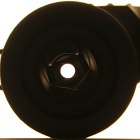 |
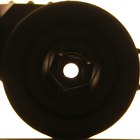 |
Distinct.
|
2/5.0 |
| Housing |
Physically light and handy, comfortable to hold. Eyecups with three detented stops move sideways. The rubber sticks out near the objectives.
|
6.3/8.0 |
| Focusing |
Central screw is comfortable (a 270-degree trun). The ring on the right eyepiece is quite comfortable, made of metal with ribbed edge.
|
4.7/5.0 |
| Tripod |
There is a convenient exit.
|
3/3.0 |
| Interpupilary distance |
from 57 to 76.3mm
|
5/6.0 |
| Closest focusing distance |
2.0 m. |
2/2.0 |
| Eyepieces FOV |
Apparent field of view of 60.5 deg (according to simple formula) and 55.7 deg (according to tangent formula).
|
11/20.0 |
| Field of view |
Measured by us amounted to 5.99 +\- 0.03 degrees and was in accordance with the specifications.
|
5.5/8.0 |
| Quality of the interior of the barrels |
The inner tube black but slightly shiny. The bottom black and matt. Clean.
|
4.4/5.0 |
| Vignetting |
| Left: |
Right:
|
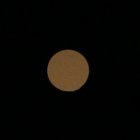 |
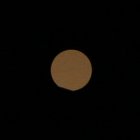 |
OL: 0.6%, OR: 1.9%. |
6.5/8.0 |
| Prisms quality |
High class BaK-4.
|
8/8.0 |
| Antireflection coatings |
Green on the objectives and prisms. Green-yellow-navy on the eyepieces. Low intensity.
|
5/5.0 |
| Warranty [years] |
30 |
5/6.0 |
| Final result |
70.9%
21st place in the overall ranking of the 10x42 binoculars test. |
134.7 / 190 pkt
|
| Econo result |
52nd place in the econo ranking of the 10x42 binoculars test.
|
-10.4pkt. |
Summary
Pros:
- relatively light casing but solid and handy at the same time,
- quite good transmission,
- slight astigmatism,
- not very high coma,
- negligible light fall-off at the edge of the field,
- high quality of prisms and coatings,
- wide IPD,
- good blackening inside,
- sharp image already from 2 metres,
- long guarantee period.
Cons:
- too small objective lenses,
- slightly egg-shaped or truncated exit pupils,
- noticeable flares.
As you see from the comparison above the ratio of pros to cons is very favourable for the Opticron. The problem is that for a flag product, apart from the three flaws mentioned above, we have here too many average results (chromatic aberration, distortion, whiteness). In the end, the final score, although still very good, is hardly impressive, especially when it comes to the price/quality ratio - in our test we can easily find many cheaper and better binoculars.




